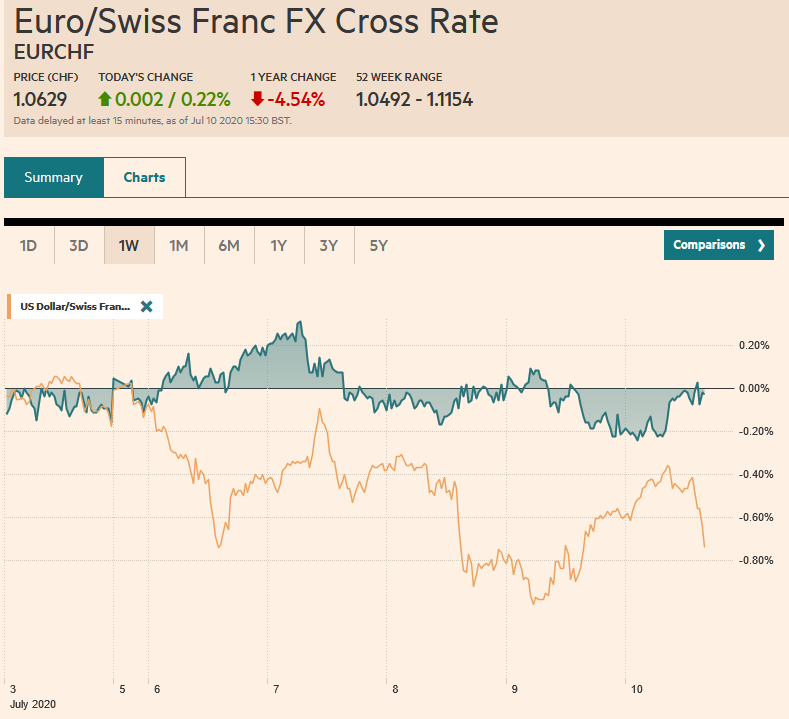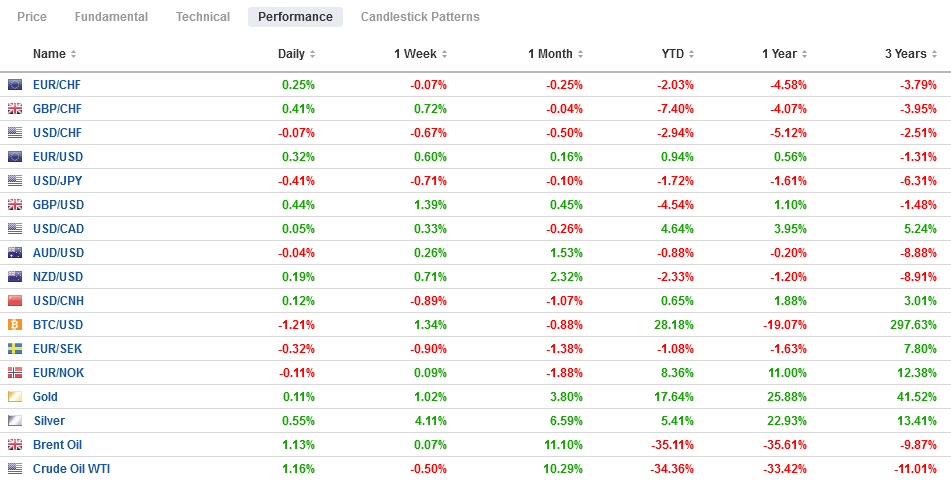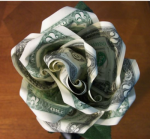Swiss Franc The Euro has risen by 0.22% to 1.0629 EUR/CHF and USD/CHF, July 10(see more posts on EUR/CHF and USD/CHF, ) Source: markets.ft.com - Click to enlarge FX Rates Overview: Record fatalities in a few US states, coupled with new travel restrictions in Italy and Australia, have given markets a pause ahead of the weekend. News that two state-backed funds in China took profits snapped the eight-day advance in Shanghai at the same time as there is an attempt to rein in the use of margin. Many of the largest markets in the Asia Pacific region fell by 1-2%, This pared the weekly gains in most markets, but sent the Nikkei and Kospi lower for the week. European shares are trying to snap a three-day fall. Several sectors are higher through the morning session,
Topics:
Marc Chandler considers the following as important: $CNY, 4.) Marc to Market, 4) FX Trends, Canada, China, Currency Movement, EUR/CHF and USD/CHF, Featured, Federal Reserve, newsletter, USD
This could be interesting, too:
Nachrichten Ticker - www.finanzen.ch writes Die Performance der Kryptowährungen in KW 9: Das hat sich bei Bitcoin, Ether & Co. getan
Nachrichten Ticker - www.finanzen.ch writes Wer verbirgt sich hinter der Ethereum-Technologie?
Martin Hartmann writes Eine Analyse nach den Lehren von Milton Friedman
Marc Chandler writes March 2025 Monthly
Swiss FrancThe Euro has risen by 0.22% to 1.0629 |
EUR/CHF and USD/CHF, July 10(see more posts on EUR/CHF and USD/CHF, ) Source: markets.ft.com - Click to enlarge |
FX RatesOverview: Record fatalities in a few US states, coupled with new travel restrictions in Italy and Australia, have given markets a pause ahead of the weekend. News that two state-backed funds in China took profits snapped the eight-day advance in Shanghai at the same time as there is an attempt to rein in the use of margin. Many of the largest markets in the Asia Pacific region fell by 1-2%, This pared the weekly gains in most markets, but sent the Nikkei and Kospi lower for the week. European shares are trying to snap a three-day fall. Several sectors are higher through the morning session, but the drag is coming from consumer discretionary, energy, and financials. US shares are trading lower, and the S&P 500 advance for the week of about 0.7% could be halved in the early going. Bonds are drawing the safe-haven bid. The US 10-year is slipping below 60 bp, and core European bond yields are mostly a couple of basis points lower. The US and UK five-year yields are at new record lows (~ 26 bp and -9 bp, respectively). The dollar enjoys a firmer bias, though the yen and Swedish krona (maybe related to bond purchases), are posting modest gains, and the euro and sterling have recovered from earlier losses and are little changed. Of note, the dollar has pushed through JPY107 to visit levels not seen for a couple of weeks. The losses in emerging market currencies between yesterday and today has left the JP Morgan Emerging Market Currency Index practically flat on the week. Gold is trading near $1807 an ounce, but the upside momentum seen earlier this week has stalled. The International Energy Agency warned that the new flare-up of cases can weaken the demand for oil. After falling 3% yesterday, August WTI is being drilled another 2% today. It is below $39 a barrel for the first time this month. |
FX Performance, July 10 |
Asia Pacific
News on the ground was thin. The surge in virus cases and the decline in US equities took a toll on regional markets. After initially seemingly encouraging equity buying, Chinese state organizations seemed to have drawn more cautious yesterday before a couple of state-run funds were quite public about their plans to take profits. Reports indicate that foreign-based funds also were sellers and for the first time this month today. Chinese data show that foreign funds were net buyers of CNY63 bln of equities this month through the linked connections. They reported slow CNY4.4 bln today, the most in almost four months. Separately, China said bank lending in June was in line with expectations (~CNY1.8 trillion), but the shadow banking surged more than expected.
The risk-off moment has seen the US dollar slump to about JPY106.70, its lowest level since June 24. Little support is seen ahead of JPY106.00. On the top side, the JPY107.00-JPY107.15 may offer nearby resistance. The Australian dollar has held above this week’s lows (~$0.6920) in the local time zone before recovering toward $0.6960 in the European morning. The intraday technicals are getting stretched. Look for resistance near $0.6970 to off the nearby cap. The broad US dollar strength proved enough to resurface above CNY7.0 after falling through yesterday.
Europe
European finance ministers picked Ireland’s Donohoe to be the Eurogroup President despite a consensus among the large countries to support Spain’s Calvino to replace Portugal’s Centeno, who is leaving the finance minister to govern the central bank. Donohoe will assume the office until mid-September. Still, a fair question is whether his selection sheds any light on the likelihood of a compromise at the July 17-18 summit about the EU Recovery Plan and budget. Did resisting Germany and France here, for example, serve as a catharsis so they will support the EC compromise? Was it a shot across the bow of the European leadership warning that it is not just the “Frugal Four” that is pushing back.
Italy and France reported large jumps in May industrial output. Italy’s industrial production surged a whopping 42.1% in May, almost twice what economists anticipated, and signals a strong recovery from the revised 20.5% drop in April (initially reported as -19.1%). The French bear was not as much, but still solid. French industrial output rose by 19.6%. Economists had hoped for around a 15.5% increase after a 20.6% slide in April (initially reported as -20.1%). Manufacturing jumped back by 22% (-22.3% in April).
The euro was sold to about $1.1255 before finding a good bid. The low for the week was set on Monday, near $1.1240. It has recovered to almost $1.13 in the European morning. It may find additional gains more difficult. There is an option for about 530 mln euros at $1.13 that expires today. The intraday technicals are stretched. The US is threatening to announce new levies on French goods in retaliation for the digital tax. Similarly, sterling has recovered from the initial selling that took it to almost $1.2565 in late Asia. It traded back to nearly $1.2620 in by midday in Europe. The intraday technicals are stretched, suggesting North American deals will be reluctant to chase it. Immediate resistance is seen near $1.2630.
America
The Fed’s balance sheet fell by $88 bln last week, the fourth weekly decline. Over this stretch, the balance sheet has shrunk by nearly $250 bln to around $6.92 trillion. It sounds kind of simple, but the reason the balance sheet is shrinking is that some things (swaps for foreign central banks and lending to primary dealers) are falling faster than the Fed is buying new assets. It purchased less than a billion dollars of corporate bonds in the past week, and the Main Street facility has yet to make a loan.
Central banks sold Treasuries from their custody account at the Federal Reserve for the second consecutive week. The $11 bln divestiture followed almost a $9 bln liquidation of the previous week. One would suspect an emerging market, but over the past two weeks, emerging market currencies have not been particularly volatile, and in this context, weak currencies are potential candidates. The weakest was the Russian rouble (~-2.6%). It has no Treasury holdings to speak of (~$7 bln as of April, according to US figures) and is most unlikely to use the Fed’s custody services. The next weakest was the Indonesian rupiah, a 1.5% decline. Maturing issues that are not recycled could also appear as a drawn down in holdings.
The US June reading of producer price may not attract much attention today. Headline PPI is likely to have remained in slight deflationary territory (below zero) but less than in May -0.8%). Excluding food and energy, producer prices have fared better. But at 0.3%-0.4% year-over-year, the lack of so-called pipeline pressure is clear. Canada’s jobs report is released at the same time. It is expected to report a strong recovery in jobs. The median forecast in the Bloomberg survey is for a 700k increase after an almost 290k rise in May. The unemployment rate may fall back to 12.1% from 13.7%. Mexico reports May industrial production figures. A small recovery is expected after falling by a quarter in April.
The US dollar made a marginal new high for the week against the Canadian dollar, just above CAD1.3620 in late Asia Pacific turnover. The greenback was consolidating near CAD1.3600 in the European morning, and initial support is seen near CAD1.3575. The week’s low was set yesterday around CAD1.3490. The US dollar is firm against the Mexican peso. It appears poised to test the high for the week near MXN22.90. The greenback finished last week a little below MXN22.40 and four-day decline in tow. With the dollar near MXN22.76, roughly had of last week’s 2.9% decline has been retraced this week.
Graphs and additional information on Swiss Franc by the snbchf team.
Tags: #USD,$CNY,Canada,China,Currency Movement,EUR/CHF and USD/CHF,Featured,federal-reserve,newsletter









